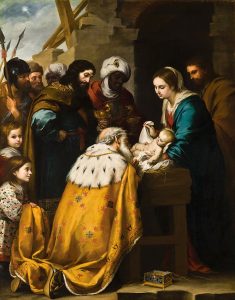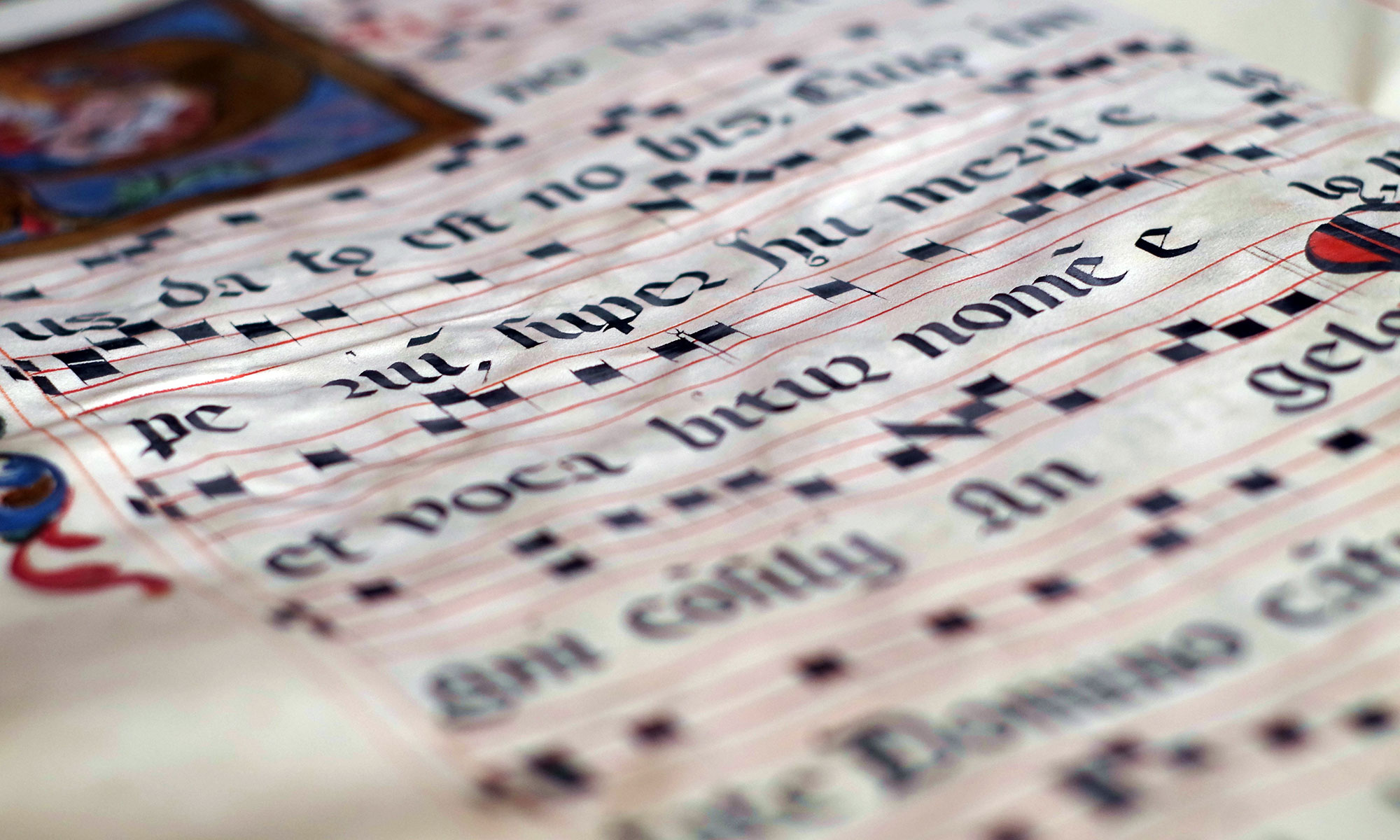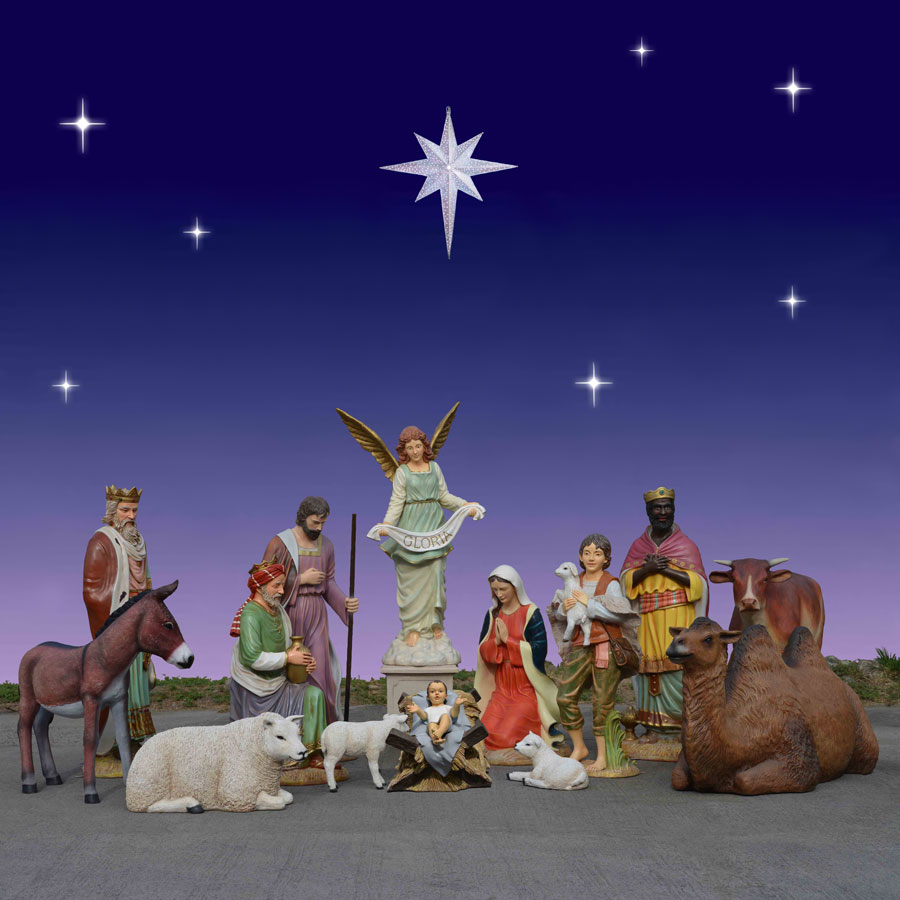 This year, as you put the finishing touches on your home’s outdoor Nativity set display, take a mental survey: name five of your favorite Christmas songs. Chances are, the short list would include at least a few of these seasonal favorites:
This year, as you put the finishing touches on your home’s outdoor Nativity set display, take a mental survey: name five of your favorite Christmas songs. Chances are, the short list would include at least a few of these seasonal favorites:
- “Jingle Bells”
- “White Christmas”
- “Winter Wonderland”
- “The Christmas Song”
- “Baby It’s Cold Outside”
- “I’ll Be Home for Christmas”
- “Rudolph the Red-nosed Reindeer”
- “I Saw Mommy Kissing Santa Claus”
John Lennon’s “Happy Christmas (War Is Over)” (1971) might also make the list, vying with Paul McCartney’s “Wonderful Christmastime” (1979). On that list there might even be The Pogues’ “Fairytale of New York,” which in various polls has been cited as the favorite Christmas song of all time in the U.K. and Ireland!
The funny thing is this—none of these aforementioned songs has much to do with Christmas per se. Yes, these non-liturgical songs may mention Santa Claus, winter weather, romance, and longing for one’s family during the holiday season, and they may all be enjoyable and appropriate for the season; but they barely allude, if at all, to the core narrative underlying all Christmas celebrations, namely, the birth of Jesus of Nazareth in Bethlehem over 2,000 years ago. In other words, the first Nativity.
What Do We Know About That First Nativity?
Surprisingly, very little. In a previous blog on the “Historical Origins of Outdoor Nativity Scenes,” we noted that peculiar fact. Considering the world-changing nature of the birth of Jesus, the New Testament is oddly reticent on the subject, describing the event only twice in the Gospels, and quite briefly:
- Luke 2:6–20
This passage describes shepherds tending their flocks. An angel appears to them announcing the birth of the Messiah, whereupon “suddenly there was with the angel a multitude of the heavenly host praising God, and saying, Glory to God in the highest, and on earth peace, good will toward men.” The shepherds then travel to Bethlehem, where they find Mary and Joseph lodging in a stable for animals, with the newborn baby Jesus lying in a manger.

(Source)
- Matthew 2:1–23
In this telling, three “Wise Men” (magi, or astrologers) from the East follow a star to Bethlehem to see the foretold “King of Jews” and to present him with gifts of gold, frankincense, and myrrh.

Esteban Murillo (Source)
Even more remarkably, these visits by the shepherds and wise men are strangely bereft of dialogue, or even casual conversation. In the New Testament accounts, no one says anything! In fact, it seems the only ones who have anything worthwhile to communicate are the angels who announce the holy birth to the shepherds. And what they say is…
Gloria in Excelsis Deo
This phrase (Biblical Latin for “Glory to God in the highest”) quotes exactly the phrase used in Luke’s Gospel. Numerous composers, from Vivaldi and Handel to Saint-Saëns and Poulenc, have set these words to hymnal music. Most casual listeners, however, will recognize them in the refrain of a popular Christmas carol, “Angels We Have Heard on High,” which includes the hymn tune “Gloria” from an 1843 French song. The song’s subject is the birth of Jesus Christ as narrated in Luke’s Gospel, specifically the scene in which the shepherds outside Bethlehem encounter a multitude of angels singing and praising the newborn child.
Angels we have heard on high
Sweetly singing o’er the plains
And the mountains in reply
Echoing their joyous strains:
Gloria in excelsis Deo!
Gloria in excelsis Deo!
Another song that echoes the Biblical Nativity story—and one that is, quite possibly, the earliest known Christmas carol—is “Jesus Refulsit Omnium” (“Jesus, Light of All the Nations”). Composed in Latin by St. Hilary of Poitiers sometime in the fourth century, this song depicts the sudden realization that enlightened the Magi when they finally arrived at the stable where the infant Jesus had been born.
It is believed that this carol was composed right after the first recorded Christmas celebration took place in 336 A.D. Despite that, nevertheless, up until the Middle Ages no one made a big deal about celebrating the Nativity. Easter and the Epiphany had a far more prominent place on the liturgical calendar. Christmas does not even appear on the lists of festivals given by the early Christian writers. It was only with the crowning of Charlemagne as emperor of the Holy Roman Empire on Christmas Day in the year 800 A.D. that the feast began to gain some prominence of its own.
St. Francis, the Nativity, and Music of the Middle Ages
The celebration of Christmas Day in its own right really began in the year 1223, when St. Francis of Assisi created the first “crèche,” or life-sized Nativity scene. He and others sang some of the first carols. These songs in the vernacular were intended as preaching aids to teach about the Nativity and other liturgical matters to the illiterate common people.
From that point on, the custom of staging Nativity scenes and singing Christmas carols spread throughout Italy, Spain, France, England, and Germany through the 14th century. The earliest extant English Christmas carol, “A child is boren amonges man,” is found in a set of sermon notes written by a Franciscan friar before 1350.
Other notable early hymns and carols from this period referencing the Biblical Nativity narratives include the following notable examples:
Make We Joy Now In This Fest
(circa 1450)
The carol mixes English with Latin, and two of the stanzas are very specific as to the source they reference:
Agnoscat omne seculum (Let all the world acknowledge Thee),
A bright star made three kings come,
Him for to seek with their presents,
Verbum supernum prodiens (Showing forth the high Word).
O lux beata Trinitas (O blessed light of the Trinity),
He lay between an ox and ass,
Beside His mother maiden free,
Gloria tibi, Domine (Glory to Thee, O Lord).
Quid Petis, O Fili?
(Richard Pygott, circa 1530)
Pygott’s macaronic (mixed-language) poem takes the listener back to medieval forms, yet his clever use of imitative polyphony turns a delightful text into quite exquisite music. The poem depicts Mary playing with her Son as a child, and begins:
The mother, full mannerly,
and meekly as a maid,
Looking on her little son,
so laughing in lap laid,
So prettily, so pertly,
so passingly well apay’d;
Full softly and full soberly
unto her sweet Son she said:
Quid petis, O fili? Mater dulcissima ba, ba.
O Pater, O fili, Michi plausus oscula da, da.
(What are you looking for, oh Son? Sweetest mother, kiss, kiss.
Oh Father, Oh Son, give me affectionate kisses.)
This work survives as the only Christmas carol in a British Library manuscript originally copied for the court of Henry VIII in the second decade of the 16th century. Here, the long, sonorous Latin burden for the chorus alternates with florid, syncopated soloists’ verses that tell the story of Mary interacting tenderly with the baby Jesus.
We’ll end this section with a performance of “Nesciens Mater Virgo Virum” (Jean Mouton, circa 1521), a quadruple canon over a plainchant melody that is without doubt one of the finest Renaissance motets for the Christmas season, with slow-moving harmonies, subtly controlled, yet rich in ideas.
Later Nativity Music
What the following hymns and carols all have in common is their real (or imagined) evocation of the sounds and circumstances of the birth of Jesus in Bethlehem as narrated in the Gospels of Matthew and Luke. Most of them are from the 19th and 20th centuries. One, however, dates back to the 12th century.
The Friendly Beasts
Of the very oldest Christmas songs mentioned in this blog, “The Friendly Beasts” is still regularly sung today and is considered a traditional Christmas song. The song is about the animals (a donkey, cow, sheep, camel, and dove) present at Christ’s birth during the nativity scene and the gifts they bring to baby Jesus. The original lyrics of the song were written by an unknown author in 12th century France. The modern English words were written by Robert Davis in 1920. Over the years, the song has been recorded by several famous singers, including Burl Ives, Harry Belafonte, Johnny Cash, and Garth Brooks. Here is the version sung by Peter, Paul & Mary:
The First Noël
This is a traditional English Christmas carol with Cornish origins, most likely from the early modern period. It mentions the angels, the shepherds, and the wise men.
We Three Kings
This Christmas carol was composed by John Henry Hopkins Jr. in 1857. The first widely popular Christmas carol written in America, the song depicts the Magi following “yonder star” in their quest to see the newborn Messiah:
O Star of wonder, star of night
Star with royal beauty bright
Westward leading, still proceeding
Guide us to Thy perfect light
The Little Drummer Boy
Written by the American classical music composer and teacher Katherine Kennicott Davis in 1941, this song was first recorded in 1951 by the Trapp Family Singers. The lyrics relate how, as a poor young boy, the drummer was summoned by the Magi to the Nativity of Jesus. Without a gift for the holy infant, the little drummer boy played his drum with approval from Jesus’ mother. It’s a nice story but, needless to say, the New Testament does not mention a drummer boy.
Silent Night
Last but not least, this highly popular and well-known Christmas carol needs little introduction. Composed in 1818 by Franz Xaver Gruber to lyrics by Joseph Mohr in a small town in Austria, it was declared an intangible cultural heritage by UNESCO in 2011. The version sung by Bing Crosby in 1935 has sold 10 million copies as a single. It perfectly captures the solemn peace and quiet that characterizes that first Nativity (drummer boy notwithstanding!).
If you plan on ordering one of Christmas Night Inc.’s beautiful, high-quality outdoor Nativity sets, think of this song as you assemble it. Nativity set and song combined will put you in the perfect holiday mood!



